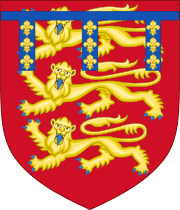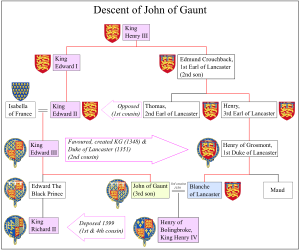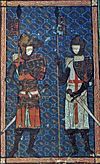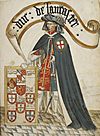Earl of Lancaster facts for kids
Quick facts for kids Earldom of Lancaster |
|
|---|---|
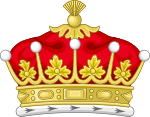
|
|
| Creation date | 30 June 1267 |
| Monarch | Henry III of England |
| Peerage | Peerage of England |
| First holder | Edmund Crouchback |
| Last holder | Henry of Grosmont |
| Subsidiary titles | Earl of Leicester |
| Extinction date | 23 March 1361 |
| Seat(s) | Lancaster Castle |
The title of Earl of Lancaster was a special rank given to important noblemen in England. It was created in 1267. This title later changed to Duke of Lancaster in 1351, but that title ended in 1361. The most recent time the Duke of Lancaster title was created, it became part of the King's own titles in 1413.
King Henry III of England created the Earldom of Lancaster for his second son, Edmund Crouchback, in 1267. The famous royal family of King Henry IV got its name from this title. Edmund had already been made Earl of Leicester in 1265. After a big conflict called the Second Barons' War, and after the leader of the rebellious barons, Simon de Montfort, 6th Earl of Leicester, died and lost his lands in 1265, many of his properties, like Kenilworth Castle, were given to Edmund.
When Edmund's son, Thomas, 2nd Earl of Lancaster, inherited more lands and titles from his father-in-law, he became the most powerful nobleman in England. He owned lands all over the kingdom and could gather large private armies. This made him and his younger brother, Henry, 3rd Earl of Lancaster, come into conflict with their cousin, King Edward II of England. This conflict led to Thomas losing his life. Henry then inherited Thomas's titles. Both Henry and his son, Henry of Grosmont, 1st Duke of Lancaster, served King Edward III of England loyally.
Contents
History of the Earldom
How the Title Began
After King Henry III of England and his supporters won against a group of English noblemen in the Second Barons' War, Henry gave titles and lands to his second son, Edmund Crouchback. These lands had been taken from the barons' leader, Simon de Montfort, 6th Earl of Leicester, who had lost his rights. Edmund received the Earldom of Leicester on October 26, 1265. Later, he was also given the first Earldom of Lancaster on June 30, 1267, and the title of Earl Ferrers in 1301. Edmund also became a Count in France through his wife. Later, King Henry IV of England would use his connection to Edmund to claim his right to the throne.
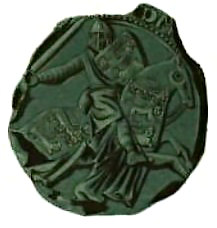
Edmund's second marriage was to Blanche of Artois. She was the widow of the King of Navarre. This marriage placed Edmund right in the middle of important European noble families. Blanche's daughter, Joan I of Navarre, was the queen of Navarre. She also became the queen of France when she married Philip IV of France. Edmund's son, Thomas, 2nd Earl of Lancaster, grew up to be the most powerful nobleman in England. He gained the Earldoms of Lincoln and Salisbury by marrying the daughter of Henry de Lacy, 3rd Earl of Lincoln. His yearly income was about £11,000, which was twice as much as the next richest earl!
Thomas and his younger brother, Henry, 3rd Earl of Lancaster, played important roles in the coronation of their cousin, King Edward II of England, in 1308. Thomas carried a special sword called Curtana, and Henry carried the royal sceptre. At first, Thomas supported Edward. But soon, he became one of the "Lords Ordainers." This group demanded that the King's friend, Piers Gaveston, be sent away and that a council of barons should help rule the country. After Gaveston was captured, Thomas led the process that resulted in Gaveston losing his life in 1312.
King Edward's power became weaker because he didn't rule well and was defeated by the Scots at the Battle of Bannockburn. This allowed Thomas to limit Edward's power by bringing back some old rules called the Ordinances of 1311. After this, Thomas didn't get very involved in ruling the country and went to Pontefract Castle. This gave Edward a chance to get his strength back. They reached a fragile peace in 1318. But in 1321, Edward's rule again led to a civil war. Thomas gathered an army from the north but was defeated and captured at the Battle of Boroughbridge. He was sentenced to a harsh punishment, but because he was the King's cousin, he was given a quicker death by beheading.
Henry, Thomas's brother, joined a revolt led by Edward's wife, Isabella of France, and her friend, Roger Mortimer, 1st Earl of March. In 1326, Henry helped capture King Edward in South Wales. After Edward was removed from power in 1326 and later died, Thomas's conviction was overturned. Henry got back the Earldoms of Lancaster, Derby, Salisbury, and Lincoln, which had been taken away because of Thomas's actions. His restored importance led to him knighting the young King Edward III of England before his coronation.
Mortimer lost support because of a treaty that made Scotland independent. Also, his growing power made other barons jealous. When Mortimer tried to make his new powers permanent, Henry led the opposition. Mortimer then attacked Lancaster's lands. King Edward III was able to take control in 1330. However, Henry's influence was limited for the last fifteen years of his life due to poor health and blindness.
Passing on the Title
Henry, the son of the previous Henry, was born at Grosmont Castle. He was born sometime between 1299 and 1314. According to his own writings, the younger Henry was better at fighting skills than school subjects. He didn't learn to read until he was older. Henry was a close friend of King Edward III and was very important during his reign. He became Edward's most trusted commander.
Henry was knighted in 1330. He represented his father in parliament and fought in Edward's war against Scotland. When the Hundred Years' War started, Henry went on several diplomatic missions and fought in smaller battles. He was also present at the great English victory in the naval Battle of Sluys in 1340. Later, he had to stay as a hostage in the Low Countries because King Edward owed a lot of money. He was a hostage for a year and had to pay a large amount of money to be set free.
In 1345, King Edward III launched a big attack on France from three different directions. Henry attacked from Aquitaine in the south. He moved quickly through the country and fought the Comte d'Isle at the Battle of Auberoche. Henry won a great victory there. The money received from the captured prisoners was estimated to be £50,000. King Edward rewarded Henry by making him one of the first knights of the Order of the Garter.
An even greater honor was given to Henry when Edward made him Duke of Lancaster. The title of duke was quite new in England. Only Cornwall had been a dukedom before this. Lancaster was also given special "palatinate" status for the county of Lancashire. This meant it had its own separate government, independent of the King's main government. There were only two other counties with this special status: Durham and Chester.
Earls of Lancaster
Family tree
| Family tree of the Earls of Leicester, and Earls of Lancaster and Dukes of Lancaster | |||||||||||||||||||||||||||||||||||||||||||||||||||||||||||||||||||||||||||||||||||||||||||||||||||||||||||||||||||||||||||||||||||||||||||||||||||||||||||||||||||||||||||||||||||||||||||||||||||||||||||||||||||||||||||||||||||||||||||||||||||||||||||||||||||||||||||||||||||||||||||||||||||||||||||||||||||||||||||||||||||||||||||||||||||||||||||||||||||||||||||||||||||||||||||||||||||||||||||||||||||||||||||||||||||||||||||||||||||||||||||||||||||||||||||||||||||||||||||||||||||||||||||||||||||||||||||||||||||||||||||||||||||||||||||||||||||||||||||||||||||||||||||||||||||||||||||||||||||||||||||||||||||||||||||||||||||||||||||||||||||||||||||||||||||||||||||||||||||||||||||||||||||||||||||||||||||||||||||||||||||||||||||||||||||||||||||||||||||||||||||||||||||||||||||||||||||||||||||||||||||||||||||||||||||||||||||||||||||||||||||||||||||||||||||||||||||||||||||||||||||||||||||||||||||||||||||||||||||||||||||||||||||||||||||||||||||||||||||||||||||||||||||||||||||||||||||||||||||||||
|---|---|---|---|---|---|---|---|---|---|---|---|---|---|---|---|---|---|---|---|---|---|---|---|---|---|---|---|---|---|---|---|---|---|---|---|---|---|---|---|---|---|---|---|---|---|---|---|---|---|---|---|---|---|---|---|---|---|---|---|---|---|---|---|---|---|---|---|---|---|---|---|---|---|---|---|---|---|---|---|---|---|---|---|---|---|---|---|---|---|---|---|---|---|---|---|---|---|---|---|---|---|---|---|---|---|---|---|---|---|---|---|---|---|---|---|---|---|---|---|---|---|---|---|---|---|---|---|---|---|---|---|---|---|---|---|---|---|---|---|---|---|---|---|---|---|---|---|---|---|---|---|---|---|---|---|---|---|---|---|---|---|---|---|---|---|---|---|---|---|---|---|---|---|---|---|---|---|---|---|---|---|---|---|---|---|---|---|---|---|---|---|---|---|---|---|---|---|---|---|---|---|---|---|---|---|---|---|---|---|---|---|---|---|---|---|---|---|---|---|---|---|---|---|---|---|---|---|---|---|---|---|---|---|---|---|---|---|---|---|---|---|---|---|---|---|---|---|---|---|---|---|---|---|---|---|---|---|---|---|---|---|---|---|---|---|---|---|---|---|---|---|---|---|---|---|---|---|---|---|---|---|---|---|---|---|---|---|---|---|---|---|---|---|---|---|---|---|---|---|---|---|---|---|---|---|---|---|---|---|---|---|---|---|---|---|---|---|---|---|---|---|---|---|---|---|---|---|---|---|---|---|---|---|---|---|---|---|---|---|---|---|---|---|---|---|---|---|---|---|---|---|---|---|---|---|---|---|---|---|---|---|---|---|---|---|---|---|---|---|---|---|---|---|---|---|---|---|---|---|---|---|---|---|---|---|---|---|---|---|---|---|---|---|---|---|---|---|---|---|---|---|---|---|---|---|---|---|---|---|---|---|---|---|---|---|---|---|---|---|---|---|---|---|---|---|---|---|---|---|---|---|---|---|---|---|---|---|---|---|---|---|---|---|---|---|---|---|---|---|---|---|---|---|---|---|---|---|---|---|---|---|---|---|---|---|---|---|---|---|---|---|---|---|---|---|---|---|---|---|---|---|---|---|---|---|---|---|---|---|---|---|---|---|---|---|---|---|---|---|---|---|---|---|---|---|---|---|---|---|---|---|---|---|---|---|---|---|---|---|---|---|---|---|---|---|---|---|---|---|---|---|---|---|---|---|---|---|---|---|---|---|---|---|---|---|---|---|---|---|---|---|---|---|---|---|---|---|---|---|---|---|---|---|---|---|---|---|---|---|---|---|---|---|---|---|---|---|---|---|---|---|---|---|---|---|---|---|---|---|---|---|---|---|---|---|---|---|---|---|---|---|---|---|---|---|---|---|---|---|---|---|---|---|---|---|---|---|---|---|---|---|---|---|---|---|---|---|---|---|---|---|---|---|---|---|---|---|---|---|---|---|---|---|---|---|---|---|---|---|---|---|---|---|---|---|---|---|---|---|---|---|---|---|---|---|---|---|---|---|---|---|---|---|---|---|---|---|---|---|---|---|---|---|---|---|---|---|---|---|---|---|---|---|---|---|---|---|---|---|---|---|---|---|---|---|---|---|---|---|---|---|---|---|---|---|---|---|---|---|---|---|---|---|---|---|---|---|---|---|---|---|---|---|---|---|---|---|---|---|---|---|---|---|---|---|---|---|---|---|---|---|---|---|---|---|---|---|---|---|---|---|---|---|---|---|---|---|---|---|---|---|---|---|---|---|---|---|---|---|---|---|---|---|---|---|---|---|---|---|---|---|---|---|---|---|---|---|---|---|---|---|---|---|---|---|---|---|---|---|---|---|---|---|---|---|---|---|---|---|---|---|---|---|---|---|---|---|---|---|---|---|---|---|---|---|---|---|---|---|---|---|---|---|---|---|---|---|---|---|---|---|---|---|---|---|---|---|---|---|---|---|---|---|---|---|---|---|---|---|---|---|---|---|---|---|---|---|---|---|---|---|---|---|---|---|---|---|---|---|---|---|---|---|---|---|---|---|---|---|---|---|---|---|---|---|---|---|---|---|---|---|---|---|---|---|---|---|---|---|---|---|---|---|---|---|---|---|---|---|---|---|---|---|---|---|---|---|---|---|---|---|---|---|---|---|---|---|---|---|---|---|---|---|---|---|---|---|---|---|---|---|---|---|---|---|---|---|---|---|---|---|---|---|---|---|---|---|---|---|---|---|---|---|---|---|---|---|---|---|---|---|---|---|---|---|---|---|---|---|
|
|||||||||||||||||||||||||||||||||||||||||||||||||||||||||||||||||||||||||||||||||||||||||||||||||||||||||||||||||||||||||||||||||||||||||||||||||||||||||||||||||||||||||||||||||||||||||||||||||||||||||||||||||||||||||||||||||||||||||||||||||||||||||||||||||||||||||||||||||||||||||||||||||||||||||||||||||||||||||||||||||||||||||||||||||||||||||||||||||||||||||||||||||||||||||||||||||||||||||||||||||||||||||||||||||||||||||||||||||||||||||||||||||||||||||||||||||||||||||||||||||||||||||||||||||||||||||||||||||||||||||||||||||||||||||||||||||||||||||||||||||||||||||||||||||||||||||||||||||||||||||||||||||||||||||||||||||||||||||||||||||||||||||||||||||||||||||||||||||||||||||||||||||||||||||||||||||||||||||||||||||||||||||||||||||||||||||||||||||||||||||||||||||||||||||||||||||||||||||||||||||||||||||||||||||||||||||||||||||||||||||||||||||||||||||||||||||||||||||||||||||||||||||||||||||||||||||||||||||||||||||||||||||||||||||||||||||||||||||||||||||||||||||||||||||||||||||||||||||||||||
See also


